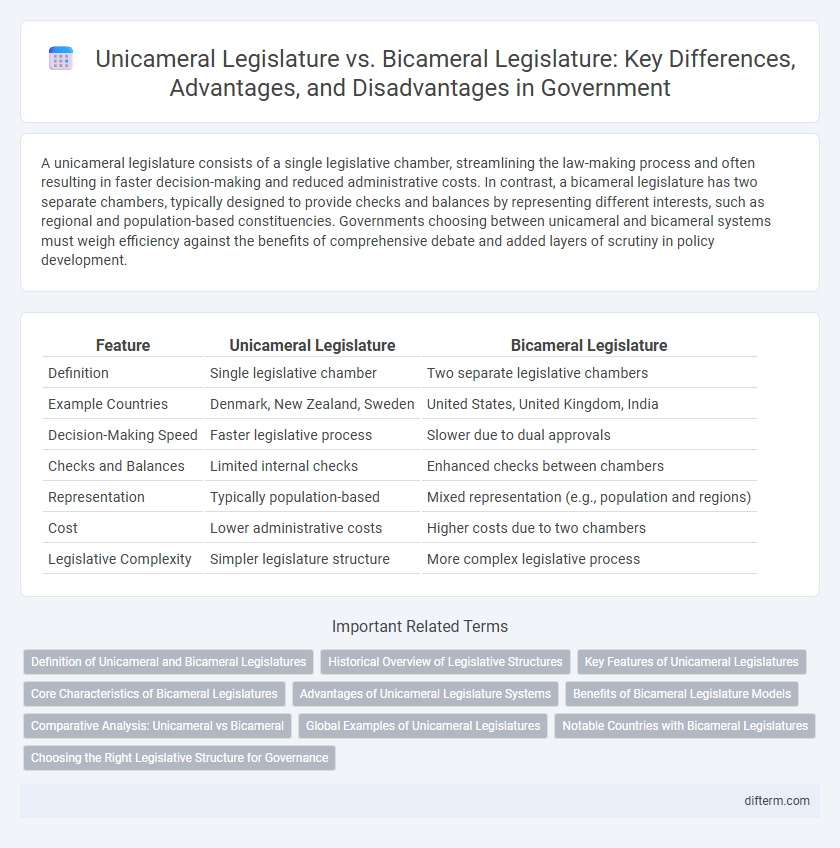A unicameral legislature consists of a single legislative chamber, streamlining the law-making process and often resulting in faster decision-making and reduced administrative costs. In contrast, a bicameral legislature has two separate chambers, typically designed to provide checks and balances by representing different interests, such as regional and population-based constituencies. Governments choosing between unicameral and bicameral systems must weigh efficiency against the benefits of comprehensive debate and added layers of scrutiny in policy development.
Table of Comparison
| Feature | Unicameral Legislature | Bicameral Legislature |
|---|---|---|
| Definition | Single legislative chamber | Two separate legislative chambers |
| Example Countries | Denmark, New Zealand, Sweden | United States, United Kingdom, India |
| Decision-Making Speed | Faster legislative process | Slower due to dual approvals |
| Checks and Balances | Limited internal checks | Enhanced checks between chambers |
| Representation | Typically population-based | Mixed representation (e.g., population and regions) |
| Cost | Lower administrative costs | Higher costs due to two chambers |
| Legislative Complexity | Simpler legislature structure | More complex legislative process |
Definition of Unicameral and Bicameral Legislatures
A unicameral legislature consists of a single legislative chamber responsible for making laws, often streamlining the legislative process and reducing redundancy. In contrast, a bicameral legislature features two separate chambers, typically an upper and a lower house, which provide checks and balances by requiring consensus between both bodies. These structural differences significantly impact the efficiency, representation, and complexity of lawmaking within a government system.
Historical Overview of Legislative Structures
Unicameral legislatures have historically emerged in smaller or more centralized states seeking streamlined lawmaking, exemplified by early Scandinavian parliaments such as Iceland's Althing. Bicameral systems developed during the Renaissance and Enlightenment periods, notably in England with the Parliament consisting of the House of Commons and House of Lords, designed to balance power between classes and regional interests. The evolution of these structures reflects efforts to address governance complexities, representing varying degrees of political centralization and accommodation of diverse social groups.
Key Features of Unicameral Legislatures
Unicameral legislatures consist of a single legislative chamber, which streamlines the lawmaking process and reduces bureaucratic delays. This system enhances legislative efficiency and accountability by concentrating decision-making power in one body, often leading to faster policy implementation. Examples of countries with unicameral legislatures include Sweden, New Zealand, and Denmark, where simplified governance structures support responsive government actions.
Core Characteristics of Bicameral Legislatures
Bicameral legislatures consist of two separate chambers, typically an upper house and a lower house, each with distinct powers and responsibilities. The upper chamber often represents regions or states, providing a check on population-based representation found in the lower chamber. This structure enhances legislative deliberation, balances power distribution, and fosters more thorough lawmaking through inter-chamber collaboration and review.
Advantages of Unicameral Legislature Systems
Unicameral legislature systems promote greater legislative efficiency by streamlining lawmaking processes and reducing bureaucratic delays. They enhance transparency and accountability as a single legislative body allows constituents to easily track decision-making and hold representatives responsible. Cost-effectiveness is another advantage, with lower operational and administrative expenses compared to bicameral systems.
Benefits of Bicameral Legislature Models
Bicameral legislatures enhance checks and balances by dividing lawmaking powers between two chambers, reducing the risk of hasty or biased legislation. This structure promotes diverse representation, ensuring both regional and population-based interests are addressed through separate houses. The dual-chamber system also facilitates more thorough debate and revision of bills, improving legislative quality and accountability.
Comparative Analysis: Unicameral vs Bicameral
Unicameral legislatures streamline the lawmaking process by concentrating authority in a single chamber, leading to faster decision-making and reduced legislative costs. Bicameral legislatures promote checks and balances through two separate chambers, often representing different interests such as regional and population-based constituencies, which enhances deliberation and prevents hasty legislation. Comparative studies highlight that unicameral systems are prevalent in smaller or more homogeneous countries, whereas bicameral systems dominate larger, federal states seeking to balance diverse political interests.
Global Examples of Unicameral Legislatures
Unicameral legislatures streamline lawmaking by consolidating legislative authority into a single chamber, enhancing efficiency and reducing bureaucratic delays. Prominent global examples include Sweden, whose Riksdag consists of 349 members, and New Zealand, where the House of Representatives operates as a unicameral body with 120 members. Other countries such as Finland, with its 200-member Eduskunta, and South Korea, featuring a 300-member National Assembly, demonstrate the diverse adoption of unicameral systems in varying political contexts.
Notable Countries with Bicameral Legislatures
Notable countries with bicameral legislatures include the United States, India, and the United Kingdom, each featuring a House of Representatives or Commons paired with a Senate or House of Lords to balance representation and lawmaking. The United States operates with a Senate and House of Representatives, providing state-based and population-based representation respectively. India's Parliament consists of the Rajya Sabha (Council of States) and the Lok Sabha (House of the People), combining federal interests with direct citizen representation.
Choosing the Right Legislative Structure for Governance
Selecting the appropriate legislative structure is crucial for effective governance, with unicameral legislatures offering streamlined decision-making and greater efficiency, while bicameral legislatures provide checks and balances through two separate chambers, enhancing deliberation and preventing hasty laws. Unicameral systems are often favored in smaller or more homogeneous countries for their simplicity and cost-effectiveness, whereas bicameral systems suit larger, diverse nations requiring representation of different regions or social groups. Analyzing factors such as population size, federal structure, and policy complexity helps governments determine the optimal balance between efficiency and thorough legislative scrutiny.
unicameral legislature vs bicameral legislature Infographic

 difterm.com
difterm.com